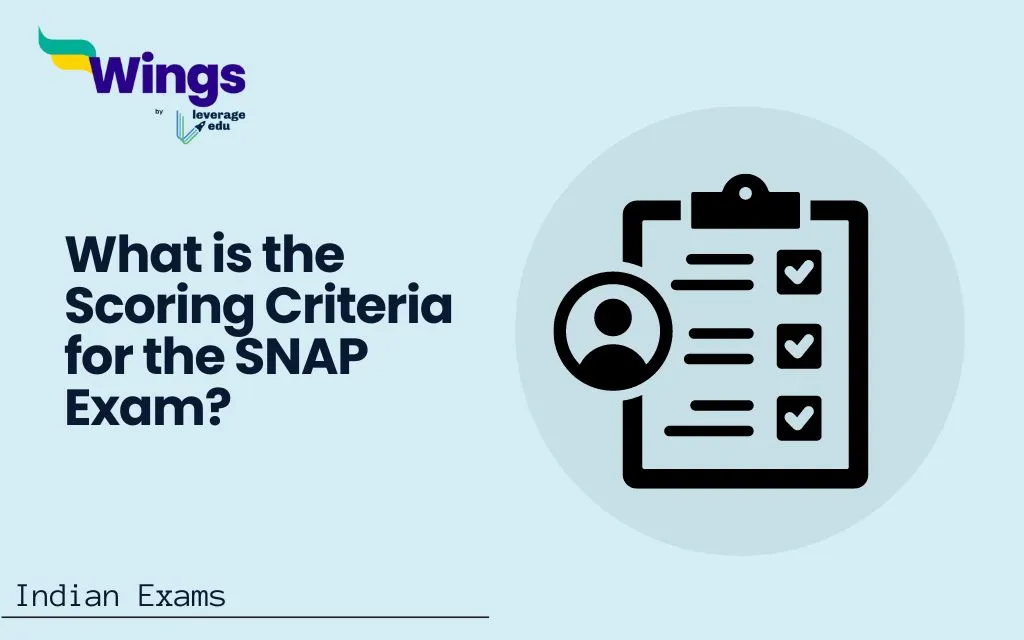What is the scoring criteria for the SNAP exam?: The SNAP scores are calculated on the basis of total points scored in the examination. Each section of the exam paper is determined by scores obtained in terms of correct and incorrect answers. The four main scoring sections of the exam are General English, Quantitative Skill, Analytical Skills and Logical Reasoning. The SNAP scorecard entails two kinds of details: scaled score and SNAP percentile. To know more about the SNAP exam scoring criteria, continue reading the blog post below.
| Exam Name | SNAP |
| Full Name | Symbiosis National Aptitude Test |
| Exam Level | National |
| Exam Frequency | Held thrice a year |
| Exam Medium | English |
| Exam Mode | Online |
| Exam Duration | 1 Hour |
| Exam Pattern | MCQ type |
| Exam Syllabus | General English, Quantitative-Data Interpretation & Data Sufficiency, Analytical & Logical Reasoning |
| Exam Fees | INR 2250 |
| Exam Purpose | Admission to SIU-affiliated universities or other institutes |
| Courses Offered | MBA/PGDM |
| Official Website | www.snaptest.org |
Contents
What is the Scoring Criteria for SNAP Exam? -Section-Wise Scoring Pattern
Each section of the SNAP exam determines a set number of questions with marks for each question. Candidates can refer to the section-wise scoring pattern for the SNAP exam shown in the table below to determine what is the scoring criteria for SNAP exam:
| Syllabus | Number of Questions | Marks Allocated |
| General English | 15 | 15 |
| Analytical & Logical Reasoning | 25 | 25 |
| Quantitative, Data Interpretation & Data Sufficiency | 20 | 20 |
| Total | 60 | 60 |
Also Read: SNAP Exam Pattern 2024: Latest Paper Pattern & Difficulty Level
How to Calculate SNAP Scores?
Candidates can easily calculate the SNAP scores by taking into account the candidate’s correct and incorrect responses. Additionally, there is no negative marking followed in the SNAP examination. To know how to calculate your SNAP scores, have a look at the formula shown below:
| SNAP Score = (Number of Corrrect Answer) x 1 – (Number of Incorrect Answers X 0.25) |
Formula to Calculate SNAP Percentile
| SNAP Percentile {(Total Number of Candidates – Rank of a Candidate)/Total Number of Candidates] x 100 |
Also Read: MBA Entrance Exams: India And Abroad
What is a Good Score in SNAP?
A good SNAP score is 40-45 out of 60 in the SNAP exam. Candidates having a good SNAP score simply makes it easier for the candidates to get admission into your choice of SIU institutes. To get a good score in the SNAP exam, candidates must know the exam pattern and prepare for it beforehand. However, candidates must note the SNAP scores vary as per their difficulty level, number of applicants, cut-off scores etc.
Also Read: Is SNAP Tougher than CAT? Know Difference between Exam Pattern, Syllabus
What is a Good Percentile in SNAP?
A SNAP percentile of 90 is considered good by many SIU institutes. Candidates having a higher percentile than 90 aid in getting admission to preferred SIU institutes effortlessly. However, a good percentile always differs each year as per the paper’s difficulty level, number of applicants, cut-off scores etc. It is crucial for the candidate to keep track of the cut-off scores and percentile scores from the previous year of the exam.
Related Reads
FAQs
The Symbiosis National Aptitude Test, popularly known as SNAP is a common entrance exam held for candidates willing to pursue an MBA in any SIU-affiliated institute in India.
The formula is used to determine the SNAP score: (Number of Correct Answers x 1) – (Number of Incorrect Answers x 0.25) is the SNAP score.
Candidates need to aim for at least 42-45 for top SIU-affiliated colleges such as SIBM Pune. However, a score of 25 would be sufficient for any lower-ranking college.
The SNAP exam’s overall difficulty level mainly ranges from moderate to difficult.
Candidates need to pay an amount of INR 2250 to register for the SNAP exam.
This was all about the “What is the Scoring Criteria for SNAP Exam?”. For more informative blogs, check out our Management Exams Section, or you can learn more about competitive exams by visiting our Indian exams page.
`
 One app for all your study abroad needs
One app for all your study abroad needs














